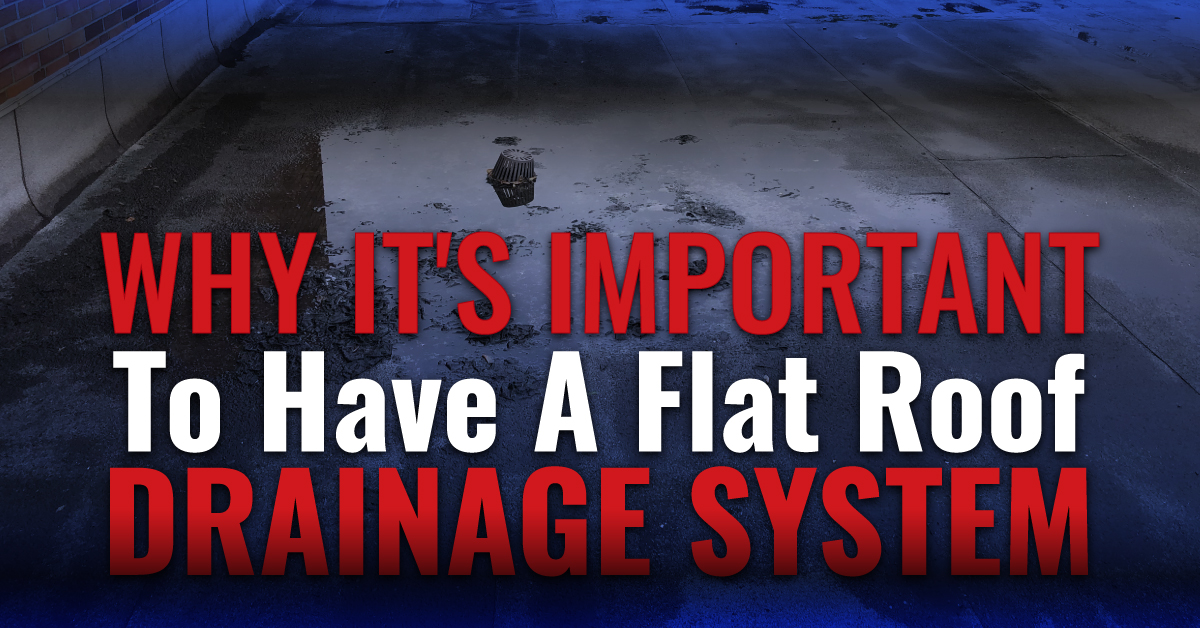Your roof is designed to protect your property, the occupants, and everything inside from rainwater to wind. So, it’s essential to keep water from ponding on your flat roof. When left to sit for long, ponding water can trigger various problems, such as plant growth, roof leaks, and further damage to your building’s structure. Consult a reputable commercial roofing contractor to establish an appropriate flat roof drainage system to help avoid this.
Why A Flat Roof Drainage System is Necessary
The key to keeping the space below a flat roof dry is to ensure rainwater drains entirely off the roof. Since flat roofs lack the pitched sections of traditional roofs, they struggle to guide the water off the roof. However, a well-engineered flat roof can drain rainwater efficiently. Even though flat roofs don’t appear to have any slope to them, they have a slight angle built on them to direct the water towards drains and gutter systems.
To enhance drainage, schedule regular maintenance to clear out clogs in gutters and downspouts. If a built-in drain system fills with debris, it can dam up water, causing the rainwater, snowmelt, and slush to buildup on the roof surface. Eventually, the moisture seeps into the building structure through seams, damaging the interior of the building.
A flat roof also requires internal drains if it spans a large area. Such drain systems carry water away from the middle of the roof and send it to the gutters and downspouts through conduits. The internal drains must be maintained periodically to eliminate any residue and debris inhibiting the water flow. A flat roof may also be used as a deck or terrace, allowing the drainage system to collect and drain water off the roof.
Types of Flat Roof Drainage Systems
There are three common types of drainage systems for flat commercial roofs. They include:
1. Internal Drains
Internal drains are common for most commercial buildings. Pipes are placed underneath the roof and in building walls. They are usually positioned towards the middle of the roof or areas where the roofing system’s slope allows rainwater to collect. Generally, internal drains are appropriate for large commercial roofs as they help drain water away from the building. Additionally, they feature a strainer to trap debris to avoid pipe blockages.
2. Gutters
A gutter system comprises a shallow trough placed beneath the roof’s edge to carry excess water away from the roof. Your roofing system must have enough of a slope to direct excess water if you want to use gutters as part of your drainage system. The most popular materials used for gutters are vinyl, aluminum, and galvanized steel. Overall, the longevity of gutters will depend on the material you choose and how well it’s maintained. To ensure gutter drainage systems work properly, you must schedule regular maintenance to clear debris.
3. Scuppers
A scupper is an opening in the sides of walls which allows rainwater to drain off a flat rooftop. It directs excess water from the rooftop into gutters or downspouts via conductor heads. You can combine scuppers with gutters and downspouts to effectively direct water flow in the correct direction. If your building has gutters or conductor heads installed, ensure the scupper spouts run past the exterior walls so the water does not wet your building.
Working with an experienced commercial roofing contractor can help you maintain an appropriate drainage system to prevent water from pooling on your roof and creating serious repercussions. Since each draining system has its own share of upsides and downsides, you should discuss with a trusted commercial roofing company to find a solution to suit your roofing system, surroundings, and other factors. Division 7 Roofing specializes in commercial roofing system installation, replacement, maintenance, and repair in Columbus, Ohio, and its surrounding areas. Contact us today to schedule a free inspection for your commercial roof.


